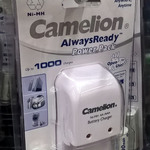After using a smart charger I would not use this — but in true OzBargain spirit I just had to share what I believe is the cheapest battery charger and rechargeable batteries combo I have found at a Australian retailer (to date).
Before you all get too excited this is what you get for a poor man's Eneloop
1x Camelion Standard Charger (Model No.: BC-0901
Main features: Charges 1 or 2 AA/AAA Ni-MH or Ni-Cd batteries, 2 Independent Charger Channels, Reverse Polarity Protection, 2 LED indicators
Charging times: AA Ni-MH 2000mAh 27 hours, AA Ni-MH 1800mAh 25 hours, AA Ni-MH 1500mAh 21 hours, AAA Ni-MH 600mAh 11 Hours
2x AA Camelion AlwaysReady Rechargeable Batteries Ni-MH 1.2V (Super high rating of 1000mAh)
More information on the battery charger can be found here http://www.camelion.com/en/products/chargers/plug-in-charger…


That's crazy dude, I have never heard of the brand but who cares.
You could buy some Aldi LSD's for $5.99 a 4 pack to go with it.